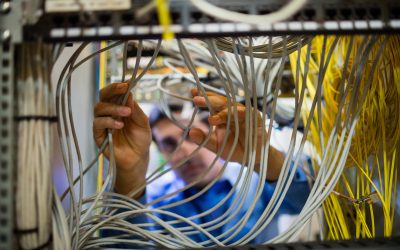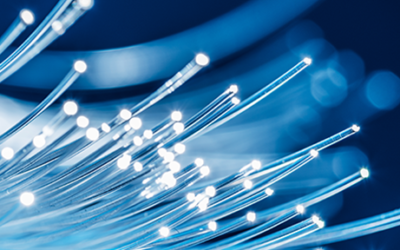Testing and Troubleshooting Fiber Optic Cabling

Tags: OLTS | OTDR | Test Equipment | Testing | training | Troubleshooting
This article describes some of the procedures for field testing and troubleshooting multimode and singlemode cabling systems.
While some fiber optic cabling system parameters such as bandwidth are important, they are not normally affected by the quality of the installation and therefore, do not require field testing.
General Testing Guidelines
SAFETY NOTE: Unterminated connectors may emit radiation if the far end is connected to a laser or LED. Do not view the end of a cable until absolutely sure that the fiber is disconnected from any laser or LED source.
In compliance with cabling standards, the following information should be recorded during the test procedure:
- Names of personnel conducting the test.
- Type of test equipment used (manufacturer, model, and serial number).
- Date test is being performed.
- Optical source wavelength, spectral width, and CPR (for multimode tests only).
- Fiber identification.
- End point locations.
- Test direction.
- Reference power measurement (when not using a power meter with a Relative Power Measurement Mode).
- Measured attenuation of the link segment.
- Acceptable link attenuation.
Types of Tests
Let us review the basic tests available to qualify and maintain any network. Fiber network infrastructure can include anything from a very short distance like a data center application or a local area network in a building where there are vertical risers or horizontal runs on the same floor, or it could even be a campus LAN or a wide area network environment. Whatever the application, the fundamental tests are similar and can be split into three categories.
The first tests are basic or fundamental tests done regularly such as a connector inspection where a hand held scope might be used. Visual Fault Location or VFL testing is used to test continuity, for example to check the polarity of a fiber from one fiber panel to another, as shown here. Power meters check power levels of, for example an output transmitter or at different points throughout the network.
The next category of tests come under the term ‘Tiers’. The cabling standards have ‘Tiers’ of testing regimes recommended for Fiber Optic Cabling. Tier 1 is testing with an OLTS (Optical Loss Test Set) where a link is being qualified, is mandatory and includes testing for length, attenuation and polarity.
The third category is Tier 2 tests which requires the use of an OTDR (Optical Time Domain Reflectometer), and gives the ability to analyse the fiber link in picture format or in a graphical format for more in-depth analysis and troubleshooting. OTDRs are used to measure loss in more detail, plus other parameters such as reflectance and return loss. The trace can be used to characterize the installed fiber link resulting in an indication of the uniformity of cable attenuation and connector insertion loss.
Selecting Test Equipment
When selecting tools to help test fiber, there are four main considerations.
- Utilize tools that drive behaviour for best practices. With cumbersome or a bunch of piece part tools, technicians are less likely to use them, so they are more likely to cut corners or form bad habits. If tools are used that are designed well and have a workflow in mind it is going to be easier for technicians to use, they are more likely to undertake functions properly and quicker.
- Use tools that allows technicians to optimize their work flow for the essential tasks. For example, when taking a typical power measurement, a technician is going to inspect, take the power measurement, clean, and measure for any visual faults in the cabling. This requires tools that allow them to do this quickly and easily. If your technicians are working smart it allows them to be working faster which means they get the job done faster and save money.
- Use a tool that can be used anywhere, in a sub-floor, overhead race way, in a demarcation point, in a outside plant application. Make sure the tool is something that’s portable.
- Probably the most important is to use tools that improves the quality of work. If expected to follow the procedures specified in the cabling standards, delivering proof that the work has been completed properly and correctly is important.
Testing and Troubleshooting
In conjunction with testing, troubleshooting optical fiber is a process of verification, isolation, repair, test, and documentation. The fault condition may be intermittent, or a total outage. Restoration is the process of returning the circuit to an operational condition.
The first stage in troubleshooting is to verify what and where the problem is. It may be helpful in the verification process, to ask the user to answer these four questions.
- Who is affected? This will include how many users or connections?
- What is the nature, scope, and severity of the condition? Is the fault intermittent?
- Where are the possible areas that the condition could occur? Is this fault in the comms room, the end destination or is it the route between one end and the other?
- When did the condition occur? If it happened at a certain time, were there other contractors working on site, was anyone working on the network?
At the site, assess the situation. Determine the priority of the condition, and the resources available to correct the problem.
Once the problem is verified, you want to isolate the problem. Begin with a thorough visual inspection. Check the patch cords. Quite often a cord will be damaged when the door or drawer to the fiber cabinet has been closed on it. If the trouble has not been identified at this stage, use a visual fault locator (VFL) to verify continuity in the circuit from end to end. This eliminates a wrong patch connection or an accidental disconnection and can prevent lots of work looking for something that is not there, especially if the fiber you think you are testing is actually a different one.
If continuity is proven but the light source at the far end of the link appears weak the next step is to thoroughly clean the connectors and adapters in all positions along the link. Dust or dirt on the end of a connector, or in the adapter, is an efficient attenuator!
Having cleaned all the connections in the channel the next step is to check the loss with an OLTS and compare it to the original documented readings to check for any difference.
If the loss is much higher that the original, look for the source of the problem with a thorough visual inspection. This should include, but not be limited to:
- Both end connectors for damage or fiber pull out.
- Any splices in the fiber for damaged or broken connections.
- Any damage or kinks in the fiber itself.
Open the fiber shelf and use the VFL again on the link under test. Depending on the sheath material, macrobends and or breaks in the fiber cores may be visible.
Be aware that because a link will pass tests in one direction, does not necessarily mean that it will pass in the opposite direction. Conditions exist, such as higher attenuation at 1300 nm than at 850 nm, for a greater loss in one direction than in the other. If the system had been tested at one wavelength and in one direction, these conditions could have existed when the fiber was originally placed. They would only become evident when the optical system was activated.
Having checked all components of the link and re-cleaned all the connectors and couplers within the link, the last stage is to test it with an OTDR. This will identify where the fault is and allow you to concentrate the remedial works on that specific area.
The final stage, after the testing process, is to repair the fault. Defective connectors or splices must be replaced and when faults are within the optical fibers, the faulty section must either be cut out and the cable re-spliced or the complete cable run replaced. After the repairs, the end-to-end connections must be re-tested to ensure they are within limits and the new test documents supplied to the customer.
We have described quite a few guidelines, considerations and procedures. At the field site, it’s easy to overlook some of them. Lets summarize!
When measuring the losses, here are the things to remember:
- Select the correct test wavelength.
- Ensure sufficient charge for battery powered equipment.
- Let the source sufficiently warm up before any measurement
- Make sure that the fiber of the test reference cords matches the fiber to be tested
- Verify the quality of test cords.
- Use cords with the same core size as the cable plant.
- Measure the source’s Coupled Power Ratio (CPR), for multimode tests, if you cannot verify it is a Category 1 CPR source.
- Use only sources that meet Category 1 CPR criteria for multimode tests.
- Apply the correct mandrel wrap or Encircled Flux adapter to the launch cord.
- Do not disturb the connection to the source after the reference measurement.
Forget any one of these may invalidate the test results. Testing fiber optic solutions is quite a detailed subject, so if you are interested in learning more, take a look at the Network Test and Inspection courses.

Written by James Donovan
You might also enjoy
FO Connector Contamination – A Constant Threat
Fiber optic communication most commonly works in duplex or multifiber transmission by transmitting light to a receiver in one direction on a fiber and receiving transmitted light back to a second receiver on the second fiber. Most engineers can understand that and...
Why Inspect and Clean Fiber Optic Connectors?
Inspecting and cleaning of fiber optic connectors during installation and when making any patching, is essential. Any contamination on a patch cord connector will be transferred through the coupler to the connector it is mated to. Even when testing fibers with a test...
Cleaning MPOs
MPO connectors should always be inspected with a scope before they are used, be that on a patch cord or a bulkhead. If they need to be cleaned, one-click cleaners are keyed to ensure the tip only fits one way onto the connectors and is able to clean both male and...


